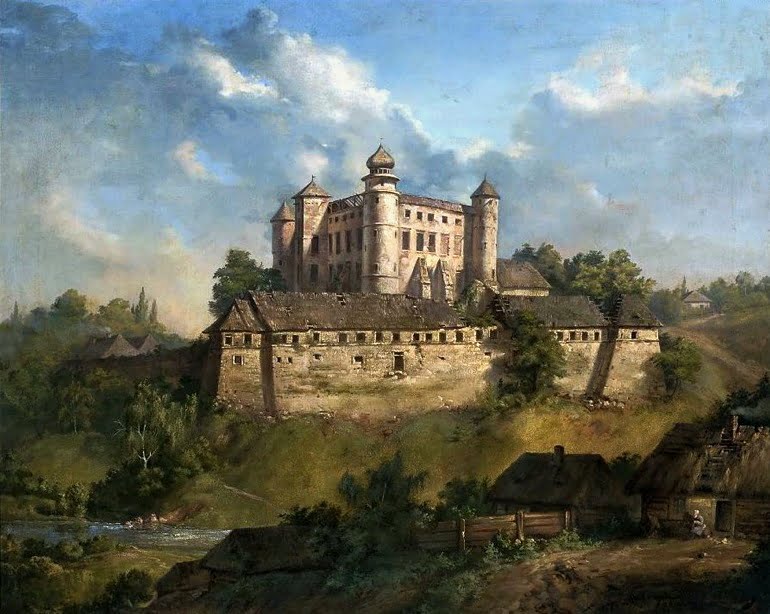Castles & Keeps

Castle Terminology
For those well versed in castle architecture, terms like parapet and portcullis are hardly worth batting an eye over, but for the uninitiated, it can be hard to remember the difference between a battlement and a bailey. The following list of commonly used terms and phrases can be a boon to readers who have not yet mastered stronghold slang.
Bailey: Also called a ward or a courtyard, the bailey is an open area within the castle complex, typically built upon a motte. An inner bailey is a courtyard surrounded by the fortification’s curtain wall, while an outer bailey occupies a space outside of the castle walls, but still within its holdings.
Barbican: A barbican is a small, defensible structure built outside of the castle walls, typically just outside a bridge or gate to the castle. It serves as a position where troops can protect potentially vulnerable points leading into the castle.
Bastion: A bastion is a tower or extension of the curtain wall. Bastions are built in strategic positions that allow garrisoned troops to repel attackers assaulting the castle’s blind spots, curtain wall, or other bastions.
Battlement: Battlements are notched parapets built on top of castle walls. They are crenellated (designed with alternatingly higher and lower barrier points, known respectively as merlons and crenels), allowing defenders to use ranged weapons from behind their cover to repel attackers. Creating a battlement is called “embattling” something.
Curtain Wall: The curtain wall is the outermost defensive wall that surrounds a castle’s inner bailey and important structures. It may feature a wall walk, battlements, turrets, and other defensive structures.
Gatehouse: Built into the curtain wall, a gatehouse allows occupants to enter and exit a castle, and varies in size and function from a simple wooden door to a complex series of reinforced doors, portcullises, and murder holes.
Keep: The keep is typically the final means of protecting important occupants of a castle—a large, heavily fortified tower that serves as a residence for nobles, favored servants, and high-ranking military personnel. It is usually built upon a motte or other defensible location within the castle.
Machicolation: These projecting galleries are built on top of curtain walls or towers, and are constructed with openings in the floor so that the castle’s defenders can rain havoc on attackers from above, dropping heavy stones, boiling water, or other harmful items on assailants.
Moat: A moat is a wide ditch dug outside of the curtain wall. It is meant to provide additional security during sieges, and can be filled with water, sharpened stakes, or other simple means of deterring attackers.
Motte: A motte is a large, sometimes artificially built mound of land upon which the keep of a castle is constructed. It affords the castle’s occupants a certain advantage in that it typically places them on higher ground than potential invaders.
Murder Holes: These narrow slits in a castle’s walls allow archers or crossbow-wielding soldiers on one side to assail enemies on the other side with arrows or bolts.
Oubliette: An oubliette is a dungeon whose only entrance and exit is a trap door in the ceiling.
Parapet: A parapet is a wall-like barrier that occupies the edge of a roof, balcony, wall walk, or other castle structure. This barrier allows the castle’s occupants to move behind it while offering them some measure of protection from outside attack. Parapets on outer castle walls are typically embattled.
Portcullis: A portcullis resembles a grate made of iron (or other materials) that slides down from inside a castle wall and blocks entry to a corridor, room, or other area of a castle. Most castles sport two portcullises in key defensive positions, enabling defenders to trap attackers between the two before assailing them with burning wood, hot oil, or other harmful weapons.
Turret: Any sort of tower or tall structure used primarily by defenders and lookouts can be referred to as a castle’s turret. Such structures can also be called tourelles or simply towers.
Wall Walk: The wall walk is the protected walkway behind a castle’s battlement, allowing soldiers to move from point to point within the castle with ease.
Section 15: Copyright Notice
Pathfinder Campaign Setting: Castles of the Inner Sea © 2013, Paizo Publishing, LLC; Authors: Alyssa Faden and Tim Hitchcock.

 Buy me a coffee
Buy me a coffee